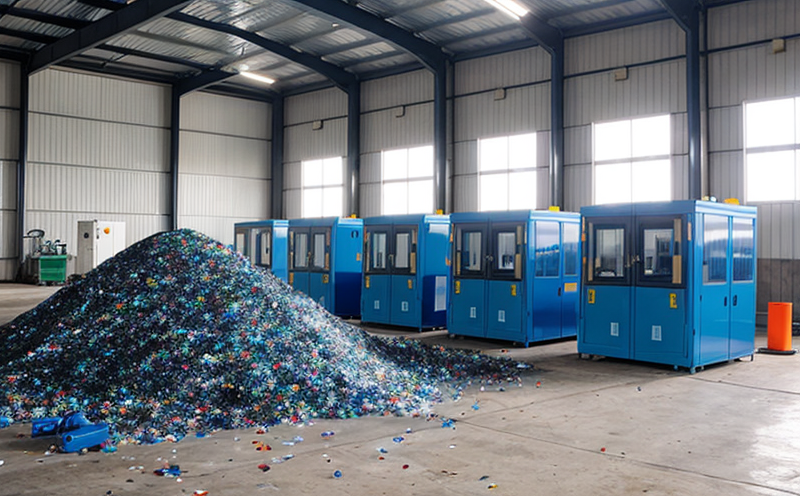ASTM D3895 Oxidative Induction Time of Recycled Polyolefins
The ASTM D3895 test method is a critical tool for the quality assurance and control of recycled polyolefin materials. This standardized procedure measures the oxidative induction time (OIT) of recycled polymers, which provides insight into their thermal stability and durability under oxidative stress.
Oxidative Induction Time is defined as the time required to reach 1% oxidation during a controlled heating process. For recycled polyolefins like HDPE, LDPE, PP, and PET, this test helps in determining the effective life of the material by identifying its resistance to oxidative degradation. This is particularly important for applications where longevity and performance under environmental conditions are critical.
The ASTM D3895 method involves subjecting a sample of recycled polyolefins to controlled heating in an oxygenated atmosphere, while monitoring the temperature at which 1% oxidation occurs. The test apparatus typically consists of a differential scanning calorimeter (DSC) or a similar thermal analysis instrument capable of precise temperature control and data recording.
Specimen preparation is crucial for accurate testing results. Samples should be cut into standard dimensions to ensure uniformity across all samples tested. It's also important to note that the sample’s history, including its recycling process, can significantly influence OIT values. Therefore, detailed documentation of the recycling process and any additives used is essential.
The ASTM D3895 test results are reported as the oxidative induction time in minutes at a specified temperature. These data points help quality managers, compliance officers, R&D engineers, and procurement teams make informed decisions regarding material selection and process optimization. The results can guide the development of new recycling processes or modifications to existing ones.
Understanding the OIT values allows for better predictions about the performance and lifespan of recycled polyolefin products in various applications, such as packaging materials, automotive components, and construction materials. This knowledge is invaluable for ensuring that recycled materials meet the same high standards expected from virgin polymers.
The ASTM D3895 test plays a pivotal role in the waste management and recycling sector by providing a standardized method to evaluate the quality of recycled polyolefin materials. It ensures consistent performance across different batches and sources, which is crucial for maintaining product integrity and reliability.
Why It Matters
The ASTM D3895 test is essential for several reasons in the context of waste management and recycling:
- Environmental Sustainability: By ensuring that recycled polyolefins have adequate oxidative stability, this test supports sustainable practices by extending the useful life of materials.
- Quality Control: It helps in identifying potential issues early on during the recycling process, allowing for corrective actions to be taken before final products are manufactured.
- Regulatory Compliance: Many regulations and standards require compliance with specific OIT values to ensure product safety and performance. This test ensures that recycled materials meet these requirements.
- Market Competitiveness: A higher oxidative induction time translates to better market acceptance and increased competitiveness, as consumers increasingly demand eco-friendly products without compromising on quality.
In summary, the ASTM D3895 test is a cornerstone in maintaining high-quality recycled polyolefin materials, which ultimately contributes to sustainable waste management practices and compliant product development.
International Acceptance and Recognition
The ASTM D3895 test method is widely recognized and accepted internationally. It is an ISO-compliant standard, ensuring its relevance and applicability across different regions and industries.
- Australia: The Australian Standard AS 4760-1999 uses the ASTM D3895 principles for evaluating the oxidative stability of recycled polyolefins.
- Canada: The Canadian Standards Association (CSA) Z27.0.3-2010 aligns with ASTM D3895 in specifying test protocols and acceptance criteria.
- European Union: European standards such as EN ISO 14608:2013 incorporate the principles of ASTM D3895 for similar applications.
- United Kingdom: The British Standard BS EN ISO 14608-2013 explicitly references ASTM D3895 for oxidative stability assessment.
The widespread adoption of ASTM D3895 in international standards underscores its importance and reliability. This standardization ensures that recycled polyolefin materials are evaluated consistently across different global markets, facilitating trade and collaboration between countries.
Competitive Advantage and Market Impact
The ASTM D3895 test method provides significant competitive advantages in the waste management and recycling sector. By ensuring that recycled polyolefins meet or exceed specified OIT values, companies can:
- Increase Product Lifespan: Enhanced oxidative stability leads to longer-lasting products, which is particularly beneficial for high-performance applications.
- Better Customer Trust: Demonstrating compliance with international standards builds trust among consumers and regulatory bodies.
- Enhanced Brand Reputation: Superior product quality translates into a positive brand image, attracting environmentally conscious customers.
- Simplified Compliance: With consistent test results, companies can more easily comply with local and global regulations regarding recycled materials.
In terms of market impact, the ASTM D3895 method helps drive innovation in recycling technologies. By providing reliable data on oxidative stability, it encourages the development of more efficient recycling processes that minimize waste and maximize material reuse. This not only benefits the environment but also contributes to economic growth through resource optimization.
Moreover, the test results can influence purchasing decisions by procurement teams, ensuring that recycled polyolefins are sourced from suppliers who meet stringent quality standards. This creates a virtuous cycle of innovation, reliability, and sustainability in the recycling industry.





